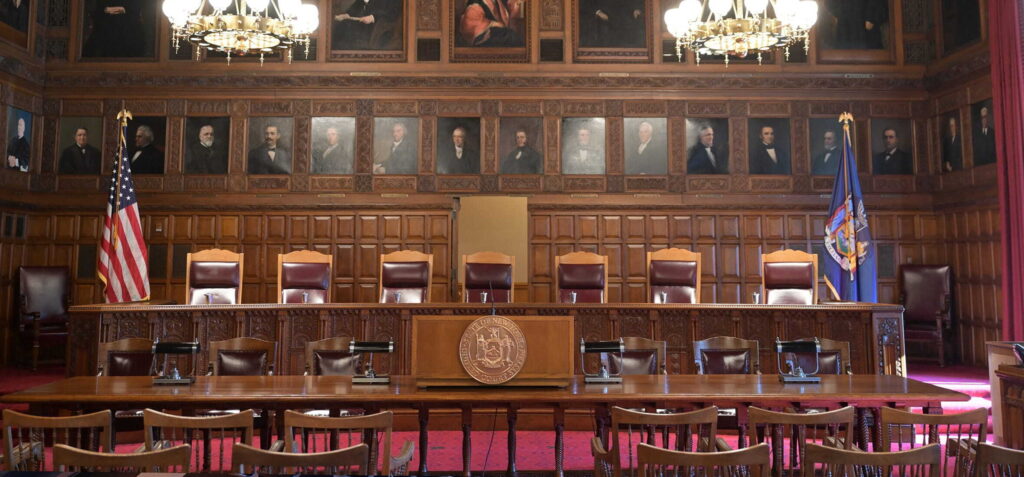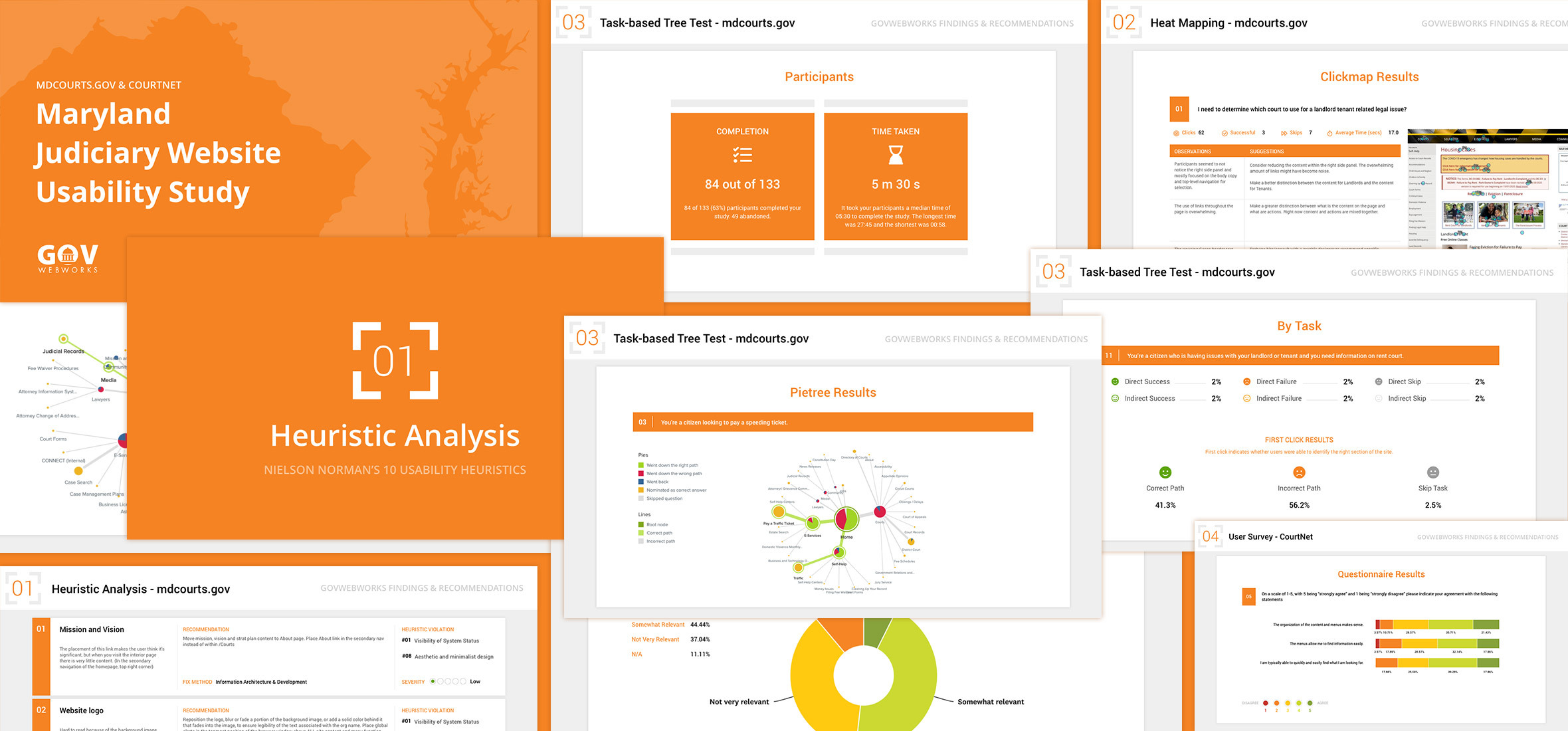Portland Webworks and GovWebworks have been supporting the judicial sector since our first project with Maine Judicial Branch in 2006. Our work in the judicial sector focuses on increasing usability for visitors to the court system websites, improving tools for Self-Represented Litigants, and building custom software to support court administrators. Our deep experience with secure open-source technologies and hosting has made us a natural fit for judiciaries and court systems for whom trusted technologies and vendors are of utmost importance.
We are proud of this work improving usability for courts and judiciaries. Here’s a look at our notable clients in the judicial sector over the past two and a half decades.
2020s
+++++++++
New York Unified Court System: Judicial branch redesign

CURRENTLY IN PROGRESS: The New York Unified Court System (NYUCS) selected GovWebworks for a comprehensive redesign of its public internet and private intranet websites to enhance user experience, streamline navigation, and improve access to information. With over 16,500 personnel and approximately one million monthly website visitors, the NYUCS project includes migrating content to Drupal 10 and reorganizing content into task-based, end-user-focused, and subject-based categories. The redesign is being managed by GovWebworks using Agile methodologies to ensure the final product includes a modern design, robust search capabilities, and accessibility features. Other deliverables include a content standards and governance manual, training sessions, and post-project technical support. Key tasks also involve content scrubbing, testing, and iterative design development for the new site to be hosted on Acquia platforms.
New Hampshire Judicial Branch: Usability redesign

CURRENTLY IN PROGRESS: The New Hampshire Judicial Branch (NHJB) website redesign project aims to enhance access to legal information and improve usability for Self-Represented Litigants (SRLs) through a user-friendly, accessible, and intuitive online platform. Key goals include increasing engagement by improving navigation and readability, simplifying complex legal concepts, and ensuring compliance with ADA and WCAG 2.1 Level AA standards. The selected vendor will perform a detailed audit of the current site, recommend improvements aligned with best practices, and propose new content and navigation structures. Deliverables include data collection and analysis, user persona insights, technical assistance, and staff training to ensure long-term usability. The redesigned website will focus on logical content organization, accessibility enhancements, and streamlined information discovery, with success measured through user satisfaction metrics and accessibility compliance.
Colorado Judicial Branch: Drupal redesign

The Colorado Judicial Branch (CJB) faced challenges with outdated technology and poor usability on its public website and intranet, resulting in confusing navigation, conflicting content, and accessibility issues. GovWebworks was selected to redesign and rebuild the website with a focus on user-centered design, accessibility, and mobile-friendliness. The project began with user research, focus groups, and stakeholder interviews to improve the site’s architecture, navigation, and content strategy. Using an agile Scrum process, the team implemented a robust Drupal CMS aligned with WCAG 2.1 AA standards. The redesigned site now offers an accessible, mobile-friendly platform with modern design, improved navigation, and a streamlined content strategy, meeting the needs of the public, legal professionals, and court administrators while ensuring sustainability and ease of maintenance.
Maryland Judiciary: Usability study and recommendations

The Maryland Judiciary (MDJ) engaged GovWebworks to conduct a usability study for its public-facing and internal websites to identify opportunities to improve user experience and navigation. Since MDJ would handle the technical implementation, the project focused on analyzing user interactions and offering recommendations. GovWebworks began with stakeholder discovery to prioritize focus areas and carried out research tasks, including heuristic analysis, heat mapping, task-based tree tests, and a CourtNet user study. Findings were compiled into a 129-page report with actionable insights, such as improving menu structure, enhancing search functionality, and addressing issues like overwhelming link density. The report also included design ideations for navigation and interaction improvements, allowing MDJ to implement changes progressively. Follow-up testing may be conducted as needed to ensure effectiveness.
2010s
+++++++++
Vermont Judiciary: Drupal modernization

The Vermont Judiciary’s (VJ) website was becoming outdated and difficult to navigate, prompting a decision in 2016 to rebuild it. GovWebworks was selected for its expertise in state agency site redevelopment and content migration, using Drupal 8 to provide ease of use and interoperability with the Judiciary’s modernized court systems. The project focused on improving accessibility and user experience through extensive research on constituent needs, which guided the new site’s design, information architecture, and content strategy. Launched in 2017, the revamped site is mobile-responsive, compliant with accessibility standards (508 and WCAG AA), and features multi-lingual support and advanced search functionality, along with distributed content management and workflow controls for staff. We continue to provide Drupal updates to the latest versions for security and usability.
Colorado Judicial Department: Security grant management system

The Colorado Judicial Department (CJD) sought a solution to streamline the distribution of state funds for courthouse security improvements, issuing an RFP to evaluate both commercial and custom solutions. After being selected for our domain expertise and understanding of project requirements, GovWebworks developed a grant management system using Spring and Hibernate Java frameworks, along with IceFaces and MyFaces UI elements, within the Department’s IBM Websphere environment. The resulting web application simplified grant applications, reviews, approvals, and fund disbursements. Following its success, a Phase II was completed to add features and integrate legacy systems, further strengthening the client relationship.
Maine Court System: ADRIS case management system

The Maine Court System (MCS) commissioned the ADRIS Case Management System to streamline the tracking and reporting of Alternative Dispute Resolution (ADR) cases, including those under the Foreclosure Diversion Program. Launched in 2011, ADRIS offers a web-based interface enabling mediators to manage profiles, submit session reports, and request payments, while allowing program managers to generate detailed reports by outcome, date, or location. The system has enhanced data integrity and monitoring of ADR programs. In 2020, updates included security enhancements, integration with the State’s Odyssey case management platform for seamless data exchange, and upgrades to ensure continued system performance and compliance with modern standards.
2000s
+++++++++
Maine Judicial Branch: Judicial information system

As our longest running public sector account. In 2006, the Maine Judicial Information System (MEJIS) was due for modernization after over a decade of use in its outdated COBOL framework, which lacked adequate documentation and required a detailed discovery process for replacement. GovWebworks led a cross-vendor team to retire the legacy system, designing an intuitive new interface integrated with the existing Oracle database. As part of the multi-year MEJIS2 modernization effort, GovWebworks was deeply involved in defining requirements, developing features, and conducting rigorous quality assurance to ensure the accuracy and reliability of each new system module. Our work with Maine Judicial Branch continues to support its mission to provide dependable, user-friendly technology that directly impacts citizens’ lives.
Learn more
- Judicial Case Studies: GovWebworks
- Judicial Sector: GovWebworks
- Contact GovWebworks to learn more about digital innovation for the judicial sector
